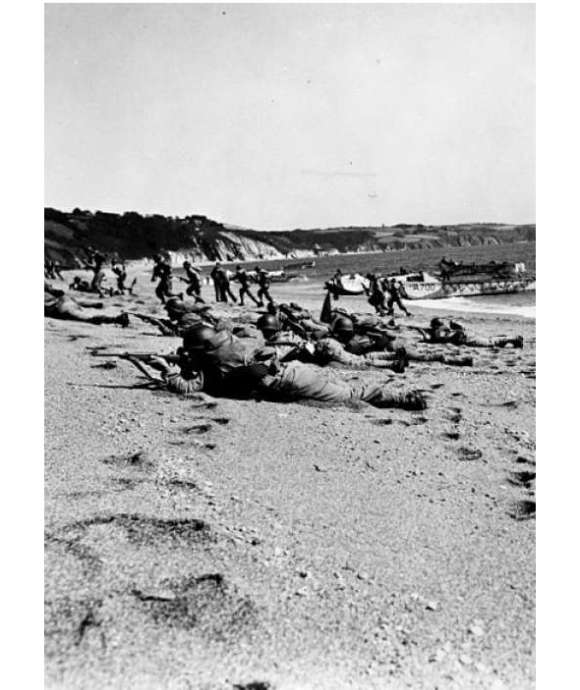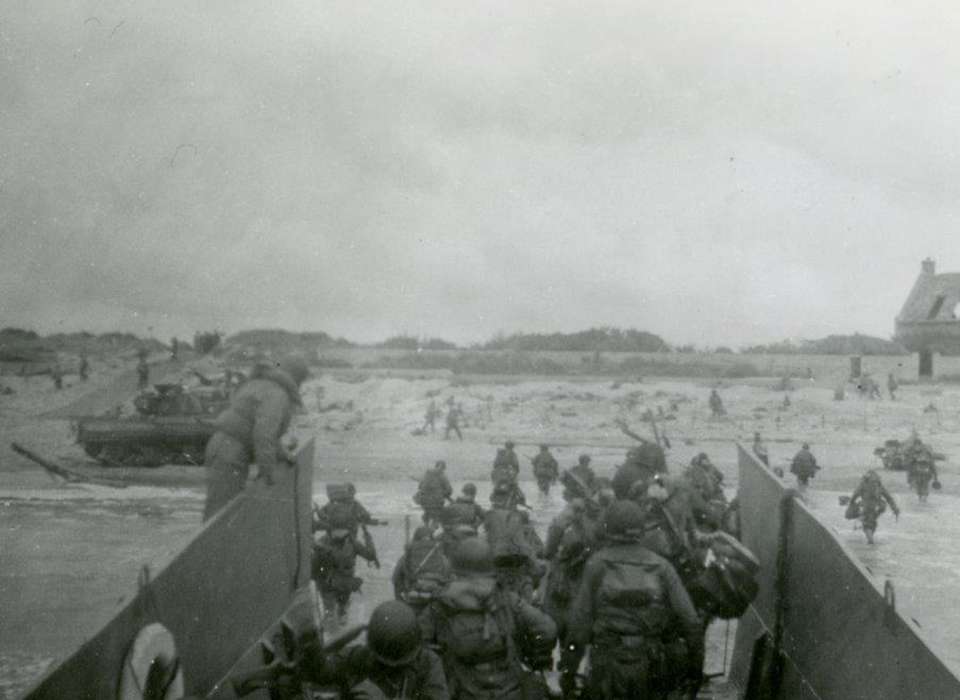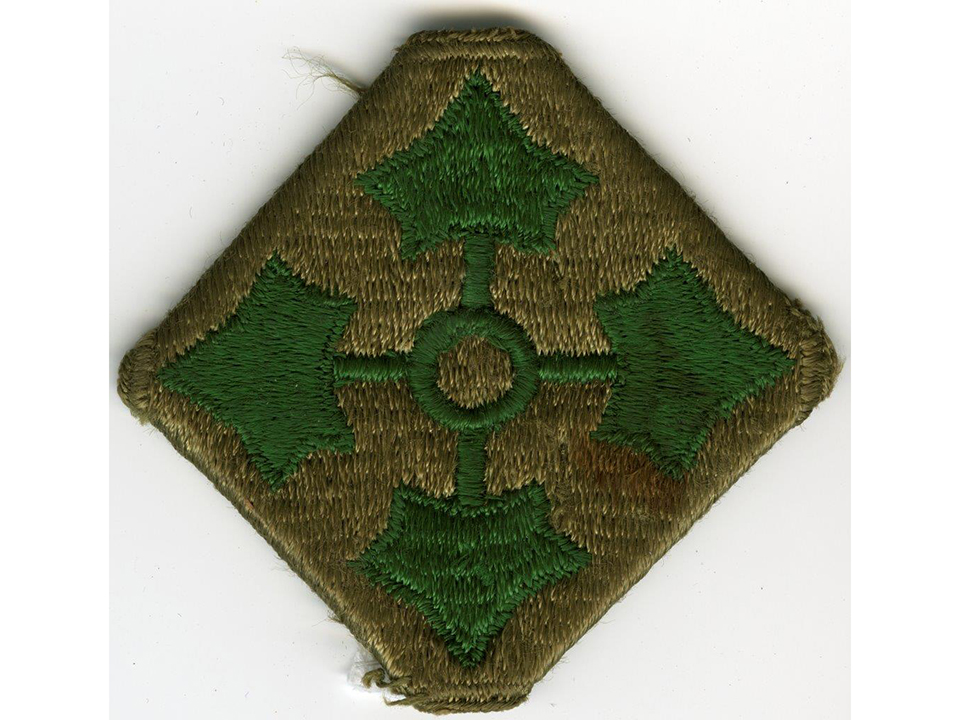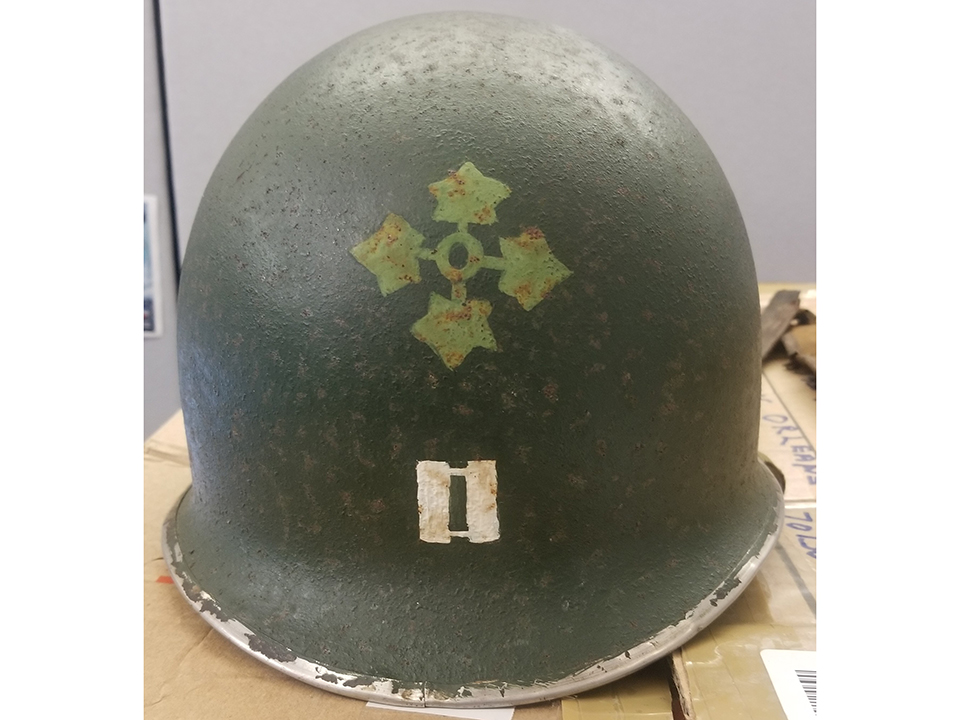Top Image: Troops disembark from an LCM onto Utah Beach. This photo was taken later in the morning as the tide had risen closer to the dunes. When Schroeder landed he had to cover 200 yards of water and almost 500 yards of open beach. Gift of Robert E. Bedford, 2012.541.017
Steel pot, tin-hat, brain-bucket: the helmet worn by US servicemen during World War II has had many nicknames associated with it. In military nomenclature it is known as the M-1 Helmet, a piece of protective headwear first adopted in 1941. The M-1 was the result of a redesign of the M1917 helmet. Instead of a brim that flared out, the M-1 was shaped to fit over and around the wearer's head. This provided additional protection to the head and neck area from falls and flying shrapnel. Although not designed to defeat a direct bullet strike, the M-1 proved to be a very effective battlefield helmet, remaining in US service into the 1980s. If it could speak, any M-1 helmet would have quite a story to tell. They were like pants or shoes, worn at all times. They protected their owners, served as a chair, were used to shave or cook, only the imagination could limit the uses of the M-1. With over 20 million produced during World War II it is not often that an individual helmet’s story is known. One of the exceptions to this is the M-1 helmet of Captain Leonard T. Schroeder, the first man to set foot on Utah Beach.
Leonard T. Schroeder was born in Linthicum Heights, Maryland in July 1918. He was a standout soccer player at Glen Burnie High School, a skill that earned him an athletic scholarship to the University of Maryland at College Park. In June 1941, Schroeder graduated and accepted a commission in the United States Army. Shortly after entering the US Army, Schroeder was assigned to the legendary 8th Infantry Regiment, 4th Infantry Division. Schroeder’s time with the 8th Infantry Regiment was unique in that he basically served in the same company, Company F, from his first assignment until he was evacuated by stretcher from Utah Beach on June 6, 1944.
The patch of the 4th Infantry Division was created during World War I. The four ivy leaves represent the roman numeral representation for the division - IV. The division distinguished its self in combat during World War I, a tradition that it continued during World War II. The National WWII Museum, 2010.161.065
The 4th Infantry Division was one of the best trained US Army divisions in World War II. Their morale was very high, partly due to the length of time the unit was together. Reconstituted in June 1940, the 4th was based on a core of prewar enlisted men and officers. They trained for years before deploying to England, destined for Operation Overlord. The faith that commanders had in the 4th was reflected in the mission that was assigned to this green division, to lead the assault on Utah Beach. By 1944, Schroeder was a captain, married, had his first child, and was in command of Company F. He had also managed to somehow make the difficult wartime transition from the reserves to the regular US Army. He intended for this to be a career after the war.
The first wave of troops to land on Utah beach numbered just over 620 men, drawn from four companies of the 8th Infantry Regiment. They were landed on the shores of occupied France by 20 US Navy and US Coastguard LCVPs. As this line of craft began the race into the beach, it just so happened that the LCVP carrying Schroeder grounded and dropped its ramp first. Leading from the front, he was the first man out into waist deep water. For the briefest moment, as he began wading forward, he was a one-man army assaulting all of Utah Beach with his M-1 helmet placed firmly on his head. Soon though, his brush with being the first was over as the rest of the first wave came pouring out of their landing craft. The men pushed through 200 yards of water, then almost 500 yards of open sand before making it to the seawall. Mercifully the casualties were light, an experience completely opposite to the bloodbath taking place on Omaha Beach. Schroeder quickly went to work, leading his company through small arms fire and exploding artillery to begin reducing the defenses that lay behind the dune line. There was death, but the assault on Utah Beach almost went exactly to plan, except for the troops landing 2,000 yards from the intended beach. Over the next few hours, Schroeder led his men inland, wiping out the beach defenders and pushing across the causeways. For his actions on the morning of D-Day, Schroeder was awarded the Silver Star.
M-1 Helmet of Captain Leonard T. Schroeder. This is an early type helmet, with the front seam visible at the bottom of the image, and fixed bales that hold the chin strap. The helmet has been painted with Captains bars and the Ivy Cross of the 4th Infantry Division. Gift in Memory of Leonard T. Schroeder.
As the attack inland began, Schroeder suddenly realized he had been wounded. Figuring he would eventually run into a medic, he continued to push on, leading his men from the front as he had done all day until he was hit again. He woke up on a stretcher on the beach, an ominous tag hung from his uniform that said to amputate his left arm. Schroeder was having none of that. For the rest of the day he refused any morphine and would not sleep until he reached the hospital in England where he pleaded with the doctor to save his arm. After being given a 50/50 chance of keeping it, Schroeder awoke in a hospital bed with severe nerve damage, but both arms. As he was recovering, a nurse came to deliver the mail. Schroeder was not interested in seeing any newspapers until the nurse told him he better look anyway because he was all over them.
That is how he found out that he had been declared the first man on Utah Beach.
In the short bond drive he participated in after D-Day, and any interview he gave until his death, he always said he may have been the first on Utah but other men, like the paratroopers, really landed first. His character and willingness to lead from the front carried on with his company. They fought well to secure Cherbourg and continue the advance through France, stopping every now and then to write him letters. Schroeder continued to serve in the US Army in Korea and Vietnam. Seventy five years after D-Day his family donated his helmet to The National WWII Museum.

Practice Makes
The ancient Romans knew what it took to win battles. You had to practice, practice, practice. Slapton Sands taught the Allies lessons, at a high price.
Joshua Schick
Cite this article:
MLA Citation:
APA Citation:
Chicago Style Citation:




![Max Fuchs, New York City cantor, sings as Rabbi Sydney [sic] Lefkowitz, Richmond, VA, conducts the first Jewish services from Germany.](/sites/default/files/styles/max_650x650/public/2025-10/image1.jpg)






